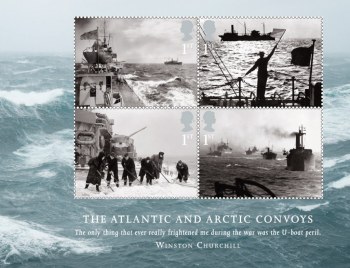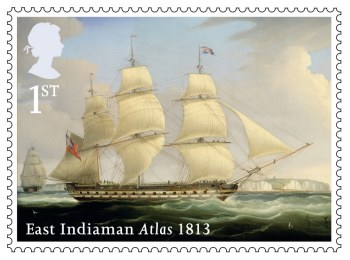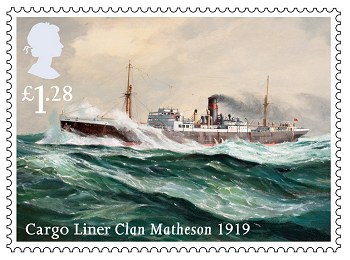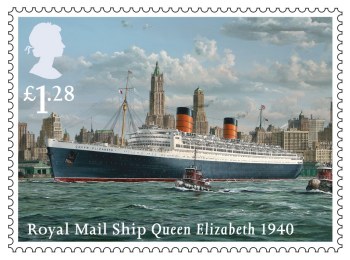
 |
Royal Mail Goes To Sea
Issued in September 2013, the Merchant Navy stamps salute the heritage of the UK's trading fleet of ships, run by various companies, which export and import good from around the world, as well as carrying passengers, and which historically have been intertwined with the fortunes of the nation.
 The accompanying miniature sheet honours the contribution of the Merchant Navy in times of war, when its ships assisted in the war effort. 2013 will mark the 70th anniversary of the turning point of what is called 'the Battle of the Atlantic', after which losses reduced considerably.
The accompanying miniature sheet honours the contribution of the Merchant Navy in times of war, when its ships assisted in the war effort. 2013 will mark the 70th anniversary of the turning point of what is called 'the Battle of the Atlantic', after which losses reduced considerably.This is a stamp subject Royal Mail has been considering for a number of years; ships on stamps are exceptionally popular and the ocean liners stamp issue of early 2004 is one of the best-selling stamp issues of the last decade.
This stamp issue will feature six individual stamps of merchant ships over the last two centuries (printed in sheets), plus a miniature sheet of four stamps focusing on the Atlantic and Arctic convoys of the Second World War.
Stamp technical details:
- Issue date: 19 September 2013
- Stamps: Six
- Design: Silk pearce
- Stamp format: landscape
- Stamp Size: 41mm x 30mm
- printer: Cartor Security printing, Meaucˇ, france
- print process: lithography
- Number per Sheet: 30/60
- perforations: 14.5 x 14
- phosphor: All over
- gum: pVA
- Issue date: 19 September 2013
- Stamps: four
- Design: Silk pearce
- Stamp format: landscape
- Stamp Size: 41mm x 30mm
- printer: Joh. Enschedˇ Stamps, Haarlem, Netherlands
- print process: lithography
- Sheet size: 115mm x 89mm
- perforations: 14.5 x 14
- phosphor: All over
- gum: pVA
 Unusually for East Indiamen, the Honourable East India Company's ship Atlas was built not on the Thames but on the Humber, by Thomas Steemson of Hull. Her first voyage was to Madras, India, and Whampoa, China, in 1813. This was the year the company lost its monopoly on trade to and from India, although it retained that of the lucrative China tea trade until 1834.
Unusually for East Indiamen, the Honourable East India Company's ship Atlas was built not on the Thames but on the Humber, by Thomas Steemson of Hull. Her first voyage was to Madras, India, and Whampoa, China, in 1813. This was the year the company lost its monopoly on trade to and from India, although it retained that of the lucrative China tea trade until 1834. She made a further voyage to Madras, Penang and Whampoa before the end of the Napoleonic War in 1815, carrying an outward cargo of various goods as well as mail, letters of credit and bullion, all of which facilitated trade. On her homeward voyage she brought tea, porcelain, silk and saltpetre for gunpowder. After two transfers of ownership and nine voyages, Captain Charles Otway Mayne, who had commanded her since her commissioning, sold her for £4,100 in August 1830, by which time she was considered fit only to be broken up.
Britannia, 1840
 Following the first crossings of the North Atlantic by steamships, the British government offered a contract worth £60,000 to carry mail to Canada and the United States. Nova Scotia's Samuel Cunard and his British partners secured the commission and ordered four paddle steamers from Clydeside shipyards.
Following the first crossings of the North Atlantic by steamships, the British government offered a contract worth £60,000 to carry mail to Canada and the United States. Nova Scotia's Samuel Cunard and his British partners secured the commission and ordered four paddle steamers from Clydeside shipyards.The first of these was the Britannia, which, although fitted with sails, was powered by a steam engine constructed by Robert Napier. Her maiden voyage left Liverpool on 4 July 1840 to be greeted at Halifax, Nova Scotia, 12 days later by cheering crowds and fireworks. Although Britannia and her sisters were soon superseded by faster, propeller-driven steamers, they established one of Britain's most enduring brand images. As the first steamer to carry letters under contract to Royal Mail, the Britannia added the abbreviation 'RMS' — 'Royal Mail Ship' — to the nautical lexicon.
Cutty Sark, 1870
 Built in 1869 by Scott & linton at Dumbarton on the Clyde for the China tea trade, the Cutty Sark was named after the chemise worn by the witch Nannie in Robert Burns's poem 'Tam o'Shanter'. At 963 tons and of composite build, with wooden planking secured to an iron frame, she was designed to carry her valuable cargo fast enough to catch the premium prices at the start of the seasonal tea market in London.
Built in 1869 by Scott & linton at Dumbarton on the Clyde for the China tea trade, the Cutty Sark was named after the chemise worn by the witch Nannie in Robert Burns's poem 'Tam o'Shanter'. At 963 tons and of composite build, with wooden planking secured to an iron frame, she was designed to carry her valuable cargo fast enough to catch the premium prices at the start of the seasonal tea market in London.Initially blighted by lacklustre commanders and the gradual loss of the tea trade to steamers when the Suez Canal opened, the Cutty Sark realised her potential in the Australian wool trade. from 1885, under Captain Woodget, she made good passages home via the stormy Southern ocean and Cape Horn.
Sold to the Portuguese in 1895, she was reacquired for the nation by Captain Dowman in 1922. Moored in Falmouth as a training ship, she was moved to the Thames in 1938 to join HMS Worcester at Greenhithe as a Merchant Navy cadet training-ship. In 1954, she was docked as an exhibit at Greenwich, where today she may be seen newly restored, an astonishing survivor of the great days of British sail.
Clan Matheson, 1919
 The Clan Matheson was launched at William Hamilton's Port Glasgow yard on 18 February 1919. )owered by a triple- expansion steam engine built by David Rowan & Co., she was registered at 5,613 gross tons. )wned by the Glasgow firm of Cayzer, Irvine, operators of the Clan line, she was 397 feet in length, with a beam of 34 feet and a speed of 11.5 knots.
The Clan Matheson was launched at William Hamilton's Port Glasgow yard on 18 February 1919. )owered by a triple- expansion steam engine built by David Rowan & Co., she was registered at 5,613 gross tons. )wned by the Glasgow firm of Cayzer, Irvine, operators of the Clan line, she was 397 feet in length, with a beam of 34 feet and a speed of 11.5 knots.The Clan line of cargo liners ran scheduled services from Great Britain to South and East Africa and to India and specialised in heavy lifts, carrying most of the rolling stock and locomotives for the Indian railways. During the Second World War, in February 1940, the ship was requisitioned by the government. She was bombed and set on fire by Japanese aircraft while at Calcutta (Kolkata), India, on 5 December 1943. Repaired, she returned to Clan line service after the war but in 1948 was sold, suffering several changes of name and ownership. In January 1955, renamed Empire Claire, the ship was loaded with obsolete ammunition and poison-gas canisters; after leaving Stranraer on 27 July, she was scuttled off Rockall in the North Atlantic.
Queen Elizabeth, 1940
 Built by John Brown on the Clyde and launched on 27 September 1938 by Queen Elizabeth, later the Queen Mother, the Queen Elizabeth was the largest ship in the world, at 83,673 registered tons and 1,031 feet in length. The ship was requisitioned by the government in March 1940 and began carrying troops, first from Australia and then, as Allied forces were built up for the D-Day invasion of France, from America to Great Britain — a total of 750,000 troops over half a million miles.
Built by John Brown on the Clyde and launched on 27 September 1938 by Queen Elizabeth, later the Queen Mother, the Queen Elizabeth was the largest ship in the world, at 83,673 registered tons and 1,031 feet in length. The ship was requisitioned by the government in March 1940 and began carrying troops, first from Australia and then, as Allied forces were built up for the D-Day invasion of France, from America to Great Britain — a total of 750,000 troops over half a million miles.In the first months of peace, the Queen Elizabeth returned troops to North America and took GI brides to their new homes. It was not until 21 October 1946 that she arrived in New York carrying 823 first-class, 662 cabin-class and 798 third-class passengers, a task that she performed regularly until 1968. By this time, the number of passengers crossing the Atlantic by sea was declining in favour of air travel.
The ship caught fire when being converted into a floating university in Hong Kong in January 1972. Having capsized, she was partially dismantled and her remains buried under the reclaimed land of a new container terminal.
Lord Hinton, 1986
 The Lord Hinton was constructed in 1986 by Govan Shipbuilders Ltd on the Clyde. She was named after Lord Hinton, a pioneer of atomic energy and the first chairman of the now defunct Central Electricity Generating Board. Her role was to carry coal from the Tyne Tees Coal Terminal to Kingsnorth power station on the River Medway in Kent.
The Lord Hinton was constructed in 1986 by Govan Shipbuilders Ltd on the Clyde. She was named after Lord Hinton, a pioneer of atomic energy and the first chairman of the now defunct Central Electricity Generating Board. Her role was to carry coal from the Tyne Tees Coal Terminal to Kingsnorth power station on the River Medway in Kent.Following the collapse of British coal mining and the privatisation of power generation, the Lord Hinton and Kingsnorth itself were acquired by the generating giant E.oN in 2004. For about a decade, the huge collier carried cargo from coal exchanges in Europe to ensure that regular just-in-time deliveries enabled Kingsnorth to supply the national [power] grid, representing the end of a tradition of coal supply by sea that dates back to the 17th century. After years of loyal service to E.oN and to the UK flag, the Lord Hinton was retired from the coal trade and the British register in December 2012. The vessel was sold for further trading in more temperate climes.